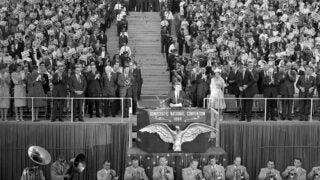Cochlear Implant Music Hour strikes a chord
USC program — supported by the university’s Good Neighbors Campaign — connects implant recipients with musicians to recapture and rediscover the feelings one gets from listening to music.
Music can soothe and inspire. But for those with a cochlear implant — a neuroprosthetic that attempts to restore sound to the deaf and hard of hearing — enjoying music is a challenge.
The devices don’t pick up subtle nuances, melodies and timing that can make music enjoyable, says cochlear implant recipient Raymond Goldsworthy, associate professor in the USC Caruso Department of Otolaryngology — Head and Neck Surgery at the Keck School of Medicine of USC.
Goldsworthy lost his hearing at age 13 and, while a cochlear implant helped him regain hearing, it has left a lot to be desired when it comes to appreciating music. His research focuses on re-creating sound, so that he and others can recapture and rediscover the feelings one gets from listening to music.
“As an engineer and a neuroscientist, a lot of my thinking has to do with how technology works — how the signal processing on the device works, how you turn the sound into electrical stimulation,” Goldsworthy says.
This challenge, plus the desire to promote overall well-being through music, is what led him to found the Cochlear Implant (CI) Music Hour Collaboration program in 2019.
Cochlear Implant Music Hour: a collaborative project
The program is a partnership between the Keck School of Medicine’s Bionic Ear Lab, the USC Thornton School of Music’s Community Engagement Program and the Neighborhood Music School in Boyle Heights, and is a 2022-23 recipient of a USC Good Neighbors Campaign grant.
The program looks beyond technology and has enlisted the expertise of USC Thornton graduate students Chrysa Kovach and Julianne Papadopoulos.
“The CI Music Hour is about promoting well-being through music collaboration,” says Kovach, co-facilitator of the Music Hour.
It connects cochlear implant recipients with local musicians to gain or regain an appreciation for music and all its wonderful nuances. Getting recipients together in one room and putting an instrument in their hands to create and hear music is the payoff, and since the program started participants have connected to musicians from around the world — even as far as Poland — for virtual jam sessions.
“Our participants tell us that this is their way to connect with similar hearing individuals and to discuss very specific experiences with people who are going through a similar situation,” says Kovach.
Now that the program has moved from virtual to in-person, Goldsworthy and his team are facing new challenges — including finding convenient locations, scheduling musicians and of course navigating Los Angeles traffic.
Despite those challenges, the results will be worth it. Doing the program online, Goldsworthy says, “you can’t really do music making the way you would like to.”



